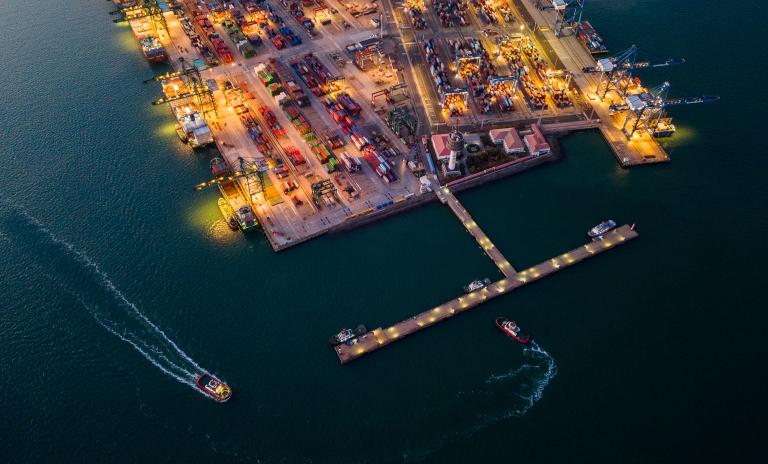After years of risk mitigation and efficiency improvements, organizations must refocus on international growth. Roland Berger has a range of solutions to help.




By Denis Depoux, Masashi Onozuka, Andrew Yi, David Zhu and Chris Ong
Global supply chains are at a breaking point. After decades of integration, the tightly woven system is beginning to fray as its hidden weaknesses come to the surface. Trade disputes, environmental legislation and geopolitical conflict are no longer short-term disruptions but structural forces that are reshaping the system. The question is not whether the old globalization model can be repaired, but how a new multi-polar order will be built in its place. We look at how the world’s industrial map is shifting, what a more regionalized supply chain means in practice, and how Asia’s transformation from the “world’s factory” to a fully integrated ecosystem could reset the balance of power.

For much of modern history, successive industrial relocations have pushed globalization forward, each wave deepening cross-border integration and assigning distinct roles to different regions: the United States and Europe dominating high-end R&D and design, Asia providing capacity in mid- to low-end manufacturing. That framework, which once promised efficiency and scale, is now being dismantled. Since the financial crisis – and even more dramatically since COVID-19 – the pursuit of resilience has overtaken the drive for efficiency. Priorities have shifted away from seamless global flows toward secure regional networks. In the process, three distinct centers of gravity are emerging: Europe is seeking to re-industrialize, North America is reshoring manufacturing and Asia is moving beyond its role as the world’s workshop to construct a complete value chain and industrial ecosystem. Together, these shifts are laying the foundation for a multi-polar global supply chain.
Unlike Europe and North America, which are concentrating on reshoring and countering de-industrialization, Asia is pursuing a different course: consolidating internally, redefining roles among its economies and deepening cross-border synergies. The central question is how individual countries will position themselves within this regional transformation. To explore this, we examine each of the major Asian economies below, identifying their historical strengths and weaknesses and determining how prepared they are to cope with the global macroeconomic shifts driving the coming changes.
As the largest economy and Asia’s hub, China still drives much of the region’s change. Recent policy shifts aim to balance domestic and international growth cycles.
China is Asia’s supply chain hub, but that position is shifting rapidly. Formerly defined by scale and low- to mid-tier manufacturing, the country is restructuring upstream industries and consolidating sectors long burdened by overcapacity in chemicals, metals and other basics. Policy incentives and the push for low carbon are accelerating the shift from outdated production toward more advanced, efficient capacities. At the same time, policymakers are trying to balance the competing demands of domestic growth and international expansion: stimulating household consumption while keeping exports competitive, and maintaining foreign investment inflows while reducing reliance on external technologies. In parallel, multinationals are reallocating resources to China, attracted by its increasingly competitive base in photovoltaics and new energy vehicles. Self-sufficiency in bottleneck technologies has become a national priority, especially given current foreign restrictions on semiconductors and other advanced fields. Progress is visible – albeit uneven – while labor-intensive production is shifting to Southeast Asia. The state of play is one of transition, with industries moving up the value chain and the ecosystem gaining global competitiveness.
Japan is a leader in advanced tech and materials, driving growth in key sectors such as the automotive industry, while revitalizing core industries and strengthening risk management.
Japan leads in advanced materials, precision equipment and high-end manufacturing, backed by strong policy support. Automotive, industrial machinery and chemicals remain global growth engines, while semiconductors and biotechnology have lost ground, and consumer sectors such as apparel and electronics generate limited value. To maintain competitiveness, Japanese firms are expanding into the global South and pursuing China+1 strategies, while the government channels investment into revitalizing strategic industries such as semiconductors and promotes wider trade partnerships to offset decoupling risks. In parallel, frequent natural disasters, stricter ESG standards, cyberthreats and geopolitical tensions are driving companies to upgrade risk management and build more resilient supply chains.
South Korea is a leader in R&D, design and core components, but faces mounting pressure from import reliance, US export sanctions and rising Chinese competition.
South Korea – one of the world’s top countries for R&D, design and core components – finds itself at a critical crossroads as US-China rivalry intensifies. Security alignment with Washington has made compliance with export controls unavoidable, reflected in major investments in American fabs such as Samsung’s 2nm facility in Texas. At the same time, dependence on China as its largest trading partner and key supplier of raw materials, particularly for batteries and chemicals, exposes structural vulnerabilities. Chinese firms are rapidly eroding South Korea’s market share in semiconductors, displays and batteries for EVs, while US sanctions and tariffs disrupt exports and complicate global manufacturing networks. To navigate these pressures, South Korean companies need to diversify their production bases, secure alternative raw material supplies and move into higher value-added segments, shifting from a manufacturing-led model to innovation-driven competitiveness.
Indonesia is set to become a battery and manufacturing hub, drawing on its vast nickel reserves. Yet infrastructure gaps, ESG risks and overreliance on China remain major hurdles.
Indonesia is emerging as Southeast Asia’s key supply chain hub, turning its vast resources into industrial strength. Holding 42 percent of the world’s nickel reserves, it is transforming into a battery powerhouse, with capacity projected to rise from ten GWh in 2024 to 140 GWh by 2030. Manufacturing already contributes about one-fifth of GDP, supported by growth in automotive, EV batteries and electronics, while intra-ASEAN trade is set to exceed USD 106 billion in 2024. Yet weaknesses remain, such as infrastructure bottlenecks, skills shortages, reliance on imported semiconductors, high logistics costs and looming ESG (environmental, social, governance) barriers linked to carbon intensity and palm oil.
Jakarta is responding with digital logistics reforms, special economic zones (SEZs) and strict rules on local content, but rising US tariffs and dependence on China for critical inputs remain major hurdles. The challenge? To turn resource strength into lasting technological capability and supply chain leadership.
Vietnam is a rising manufacturing hub with record foreign direct investment in chips, electronics and electric vehicles. But supply chain gaps, talent shortages and dependence on the United States and Canada need to be addressed.
Vietnam is fast becoming a critical node in Asia’s supply chains, with manufacturing now contributing about one-quarter of GDP and foreign investment of USD 38 billion in 2024 funding chip fabs, electronics expansion and VinFast’s EV ambitions. The country leads ASEAN in manufacturing growth and is positioning itself to move beyond assembly into full value-chain participation – targeting three semiconductor fabs, 300 design houses and 20 packaging plants by 2040. Strong trade agreements such as CPTPP, EVFTA and RCEP, combined with cost-competitive assembly, underpin Vietnam’s rise as a leading apparel exporter and emerging EV and electronics hub. Weaknesses include a dependence on imported cotton and semiconductor materials, limited finishing capacity, infrastructure constraints, shortages of advanced engineering talent and elevated inland logistics costs. Heavy reliance on the United States (30 percent of exports) and China (17 percent) exposes earnings to tariff shocks, making diversification and continued investment essential to sustaining growth.
Thailand is focusing on electric vehicles and advanced electronics, backed by national incentives and the Eastern Economic Corridor (EEC). But high import dependence, logistics bottlenecks and tariff pressures threaten future competitiveness.
Thailand – Southeast Asia’s automotive hub – is pushing into EVs and advanced electronics with THB 848 billion in incentives and the USD 44 billion Eastern Economic Corridor. The goal? To raise battery electric vehicle (BEV) output from 93,000 units to 2.5 million by 2040, drawing investment from BYD, Great Wall and Mercedes-Benz. Motor vehicles and electronics already make up nearly 40 percent of exports, supported by strong inputs in rubber, petrochemicals and silicon processing, as well as growing FDI in digital industries. Risks remain in the country’s reliance on imported semiconductors and battery materials, customs bottlenecks, inefficient logistics and tariff exposure. Rising US tariffs – now averaging 36 percent – threaten key exports, while cheap Chinese inflows pressure local firms. Sustaining competitiveness will require diversifying suppliers, accelerating digitalization and at the same time moving further up the value chain.
Malaysia leads in semiconductor assembly and testing (OSAT), with new investments pushing into wafer fabs and advanced R&D. Pro-growth policies and deeper capabilities can help manage exposure to the United States and China.
Malaysia is a global leader in outsourced semiconductor OSAT, accounting for around one-third of global volumes – although the country’s regional share is slipping from 43 percent in 2018 to a projected 33 percent by 2025. Long known for packaging and testing expertise, it is now channeling more than USD 11 billion into wafer-fab upgrades and advanced R&D, with Penang and Johor emerging as hubs for semiconductors and EV components. Foreign investment in electronics has grown at an 18 percent CAGR over the past decade, underpinned by strong petrochemical and polymer inputs. Yet challenges persist: rising wages are eroding cost competitiveness, infrastructure remains uneven outside major industrial zones and talent shortages in advanced engineering constrain expansion. Heavy dependence on Chinese raw materials and exposure to the United States and China – together accounting for nearly half of exports – further amplify risks. Sustaining competitiveness will require broader upstream capabilities and a workforce able to handle more complex technologies.
Singapore anchors Asia’s high-value supply chains. R&D, digital advancement and green logistics are critical to offset rising costs and dependence on energy imports and China.
Singapore captures the largest share of ASEAN FDI. Its world-class logistics and transparent legal system and highly skilled workforce attract many regional headquarters as well as trade finance. Precision engineering, semiconductors, petrochemicals and medical technology keep it central to Asia’s high-value supply chains, although rising costs and heavy reliance on imported energy and raw materials expose its structural risks. Regional rivals are offering cheaper land and labor, eroding its cost edge, while around one-third of machinery exports go to China and Hong Kong, leaving earnings vulnerable to geopolitical shocks. Singapore’s answer is to lead in deep tech and green logistics, with initiatives in zero-emissions shipping and enterprise R&D aimed at reinforcing its role as Asia’s innovation hub.
The Philippines accounts for ten percent of global outsourced and semiconductor assembly and testing (OSAT) capacity and has the world’s second-largest BPO workforce. High power costs and reliance on China and the United States make diversification and value-added growth essential.
The Philippines is responsible for about ten percent of global semiconductor assembly and test capacity and has the world’s second-largest BPO workforce, giving it a mix of goods exports and services earnings. Electronics dominate, with labor-intensive assembly of semiconductors, hard disk drives (HDDs) and consumer devices driving more than half of export value. On the services side, the BPO sector contributes roughly nine percent of GDP and employs more than 1.3 million people. Geothermal and nickel resources add strength in clean energy and EV batteries – but high power costs and heavy export dependence on China and the United States restrict diversification. Current policy focuses on renewable power, logistics upgrades and higher-value services to mitigate these constraints, in so doing strengthening the Philippines’ position as a competitive supply chain base.
Asia’s current trajectory points toward a decisive realignment – from fragmented, multi-chain rivalry to single-chain leadership, and from homogeneous competition to collaborative symbiosis. The region’s strengths are clear: China’s vast industrial infrastructure and push for self-sufficiency, Taiwan’s technological dominance in semiconductors, Japan’s advanced materials and precision equipment, South Korea’s leadership in batteries and core components, and Southeast Asia’s abundant resources, fast-growing EV clusters and cost-competitive manufacturing. But there are significant weaknesses too, ranging from structural overcapacity in steel, chemicals and mid-tier electronics to overexposure to US-China trade frictions and tariff shocks.
Together, these strengths and weaknesses form the foundation for transformation. If Asia can channel its scale, technology and resources into more integrated and resilient networks, the region will not simply adapt to deglobalization – it will emerge as the primary architect of the next global value chain.
Register now to access the full study and explore how Asia’s supply chains transform amid global shifts. Furthermore, you get regular news and updates directly in your inbox.